- 1Faculty of Physical Education, Shanghai International Studies University, Shanghai, China
- 2Faculty of Movement and Rehabilitation Sciences, KU Leuven, Leuven, Belgium
- 3Lothian Birth Cohort, Department of Psychology, The University of Edinburgh, Edinburgh, United Kingdom
- 4School of Physical Education, Shanghai Normal University, Shanghai, China
Background: Mild cognitive impairment (MCI) is a common neurodegenerative disorder that poses a risk of progression to dementia. There is growing research interest in body–mind exercise (BME) for patients with MCI. While we have observed a rapid growth in interest in BME for MCI over the past 10 years, no bibliometric analysis has investigated the knowledge structure and research trends in this field. Consequently, the objective of this research is to conduct a bibliometric analysis of global publications of BME for MCI from 2013 to 2022.
Methods: A total of 242 publications in the field of BME for MCI were retrieved from the Web of Science Core Collection. Bibliometric analysis, including performance analysis, science mapping, and visualization, was performed using CiteSpace, VOSviewer, and Microsoft Excel.
Results: Publications and citations in the field of BME for MCI have shown a rapidly increasing trend over the last decade. Geriatrics & Gerontology, and Neurosciences were the most frequently involved research categories. China (78 documents) and the USA (75 documents) contributed to the largest number of publications and had the strongest international collaborative networks. Fujian University of Traditional Chinese Medicine contributed to the largest number of publications (12 documents), and Chen, L of this institution was the most prolific author (12 documents). Frontiers in Aging Neuroscience (16 documents), and JOURNAL OF ALZHEIMER’S DISEASE (12 documents) were the most prolific journals. Tai Chi and Baduanjin, as specific types of BME, were the hotspots of research in this field, while evidence synthesis and guidelines might be future research trends.
Conclusion: In the last decade, there has been a rapid growth in scientific activities in the field of BME for MCI. The results of this study provide researchers and other stakeholders with knowledge structure, hotspots, and future research trends in this field.
1 Introduction
As global aging accelerates, cognitive decline, including mild cognitive impairment (MCI), has attracted growing concerns from researchers, clinical practitioners, as well as a wide range of other stakeholders (1). As a status between normal cognitive aging and dementia, MCI has emerged as a priority in both research and clinical practice to delay the development of neurodegenerative disease (2). MCI typically consists of memory impairments accompanied by abnormal memory test scores, affecting professional and social activities, but with maximum preservation of activities of daily living (3). The latest meta-analysis proposed that 15.6% of adults over 50 years old were suffering from MCI (4), while the incidence of MCI was 22.5, 40.9, and 60.1% in people aged 75–79 years, 80–84 years, and over 85 years, respectively (5). Due to the natural trajectory of cognitive decline, aging is a risk factor for MCI, while males are more prone to suffer from MCI than females (6). More importantly, MCI carries a varying cognitive developmental trajectory, including a reversal to normal cognitive function, retention of stability, and progression to dementia (7). Previous research suggested that approximately 80% of patients with MCI may have converted to Alzheimer’s disease with annual conversion rates around 10–15% (8–10). Meanwhile, it was reported that 18% of patients reversed from MCI to normal cognitive function (11). Nevertheless, the risk of cognitive decline is still higher for patients with MCI than for people with a normal trajectory of cognitive decline (12). Furthermore, patients with MCI are commonly accompanied by a variety of neuropsychiatric symptoms and reduced ability to perform activities of daily living (13). The average annual direct medical costs for an individual with MCI in the USA were estimated at $6,499, which is substantially higher than those without MCI ($2,969) (14). Therefore, MCI, as a prevalent cognitive disorder among middle-aged and elderly people, needs to be prevented and treated with more action, especially in this aging world.
Even though a number of pharmacological interventions have been developed to treat MCI (15–17), none of them has been reported to be effective (7). Meanwhile, exercise has shown potential value as a non-invasive and highly feasible non-pharmacological treatment for patients with MCI (18). The body–mind exercise (BME), which combines body movement, mental focus, and controlled breathing to improve strength, balance, flexibility, and overall health (19), has been reported to benefit on cognitive disorders such as MCI among middle-aged and elderly adults (20–22). Fabre et al. (23) proposed that combined aerobic and mental training was more effective than separate aerobic or mental training in memory quotient among healthy older adults. Similarly, Theill et al. (24) found that 10 weeks of combined cognitive and physical training was more effective for cognitive performance than single cognitive training among older adults. More recently, Tai Chi, Yoga, Qigong, and other types of BME have been increasingly employed to enhance cognitive function and to manage MCI among older adults (25–27).
As mentioned above, researchers have conducted quite a few in-depth original investigations of BME for MCI, and this has resulted in several evidence syntheses, such as systematic reviews, and meta-analyses (28, 29). These kinds of syntheses employ systematic approaches that allow for the robust extraction of qualitative or quantitative information from publications and then identify the existing evidence on various specific research questions (30). However, these syntheses are not suitable for a broad and rapidly developing research field and fail to deal with highly heterogeneous publications (30). For instance, in the field of BME for MCI, the original investigations include randomized controlled trials and laboratory mechanistic studies. Existing approaches, whether systematic reviews or meta-analyses, are unable to synthesize evidence from interventions’ effectiveness and evidence from imaging reports simultaneously.
Therefore, Nakagawa et al. (31) proposed a “Research Weaving” framework that combines bibliometrics and systematic mapping to reveal and visualize the knowledge structure and research trends in a research field. The major advantage of this approach is that it allows for the synthesis of a large number of heterogeneous scientific publications, thus providing better insights into the knowledge structure and future research trends (30). Considering these advantages, bibliometric analyses have begun to become a standard instrument in science policy and research management (32). In research fields related to BME for MCI, such as exercise for Parkinson’s Disease (33), and neuroinflammation-induced MCI (34), bibliometric analysis has provided a one-stop overview of the field, as well as the identification of knowledge gaps. Nevertheless, there is an absence of bibliometric analysis in the field of BME for MCI. Therefore, a robust bibliometric analysis of BME for MCI, which is a rapidly growing field with highly heterogeneous publications, is required to support researchers to identify future research directions and to provide quantitative evidence for policy makers to identify future funding priorities.
Accordingly, this research aims to assess the knowledge structure of the field of BME for MCI from 2013 to 2022, and to predict future research directions. Specifically, this present research will answer the following research questions: (1) Which country, institution, author, discipline, journal, and reference significantly contributed to the research in the field of BME for MCI? (2) What are the research trends in the field of BME for MCI from 2013 to 2022? (3) What are the hotspots of research in the field of BME for MCI?
2 Methods
2.1 Data source and search strategy
This study was conducted in rigorous accordance with the step-by-step guidelines for bibliometric analysis (30).
All eight indexes of the Web of Science Core Collection (WoSCC) were utilized as an electronic database for this bibliometric analysis. The rationale for WoSCC is that, as this study aims to perform a bibliometric analysis of the multidisciplinary field of BME for MCI, the usage of specialist field databases such as PubMed and SPORTDiscus may result in an omission of search results. Furthermore, using multiple databases can introduce bias into subsequent bibliometric analyses because of the differences in data formats and the included information of various databases (e.g., the difference between WoSCC and Scopus@ regulations on author initials) (35). As WoSCC provides the most extensive information for bibliometric analysis compared to other multidisciplinary electronic databases such as Google Scholar and Scopus@, WoSCC was chosen as the only database in this study (36). Moreover, WoSCC has been successfully used by researchers as a data source to conduct bibliometric analysis in the field of Tai Chi for Health (37), electroencephalogram research in MCI (38), and other fields related to BME for MCI.
As recommended by the guidelines for conducting bibliometric analyses, the search strategy used for this study was defined by the keywords used in the previous reviews in the field of BME for MCI, as well as brainstorming by all the authors (30). Taking into account the update of the WoSCC electronic database, all data were retrieved on March 13, 2023, to eliminate search bias. Keywords related to BME were entered in the topic column and recorded as #1, while keywords related to MCI were entered in the topic column and recorded as #2. The final search strategy is available in Supplementary material. The document type was set as “Article” and “Review Article,” the timespan was set as 2013–2022, and the language of publication was limited to English. The reason for limiting the search to the last 10 years is that the BME for MCI research field has developed over a relatively short period and that 10 years of bibliometric analyses have already demonstrated their ability to detect the knowledge structure and to predict research trends in previous studies (39). The flow chart of the literature search was shown in Figure 1. This search strategy resulted in 242 eligible documents, and basic information about each document was downloaded from the electronic database in formats of plain text files and tab-delimited files.
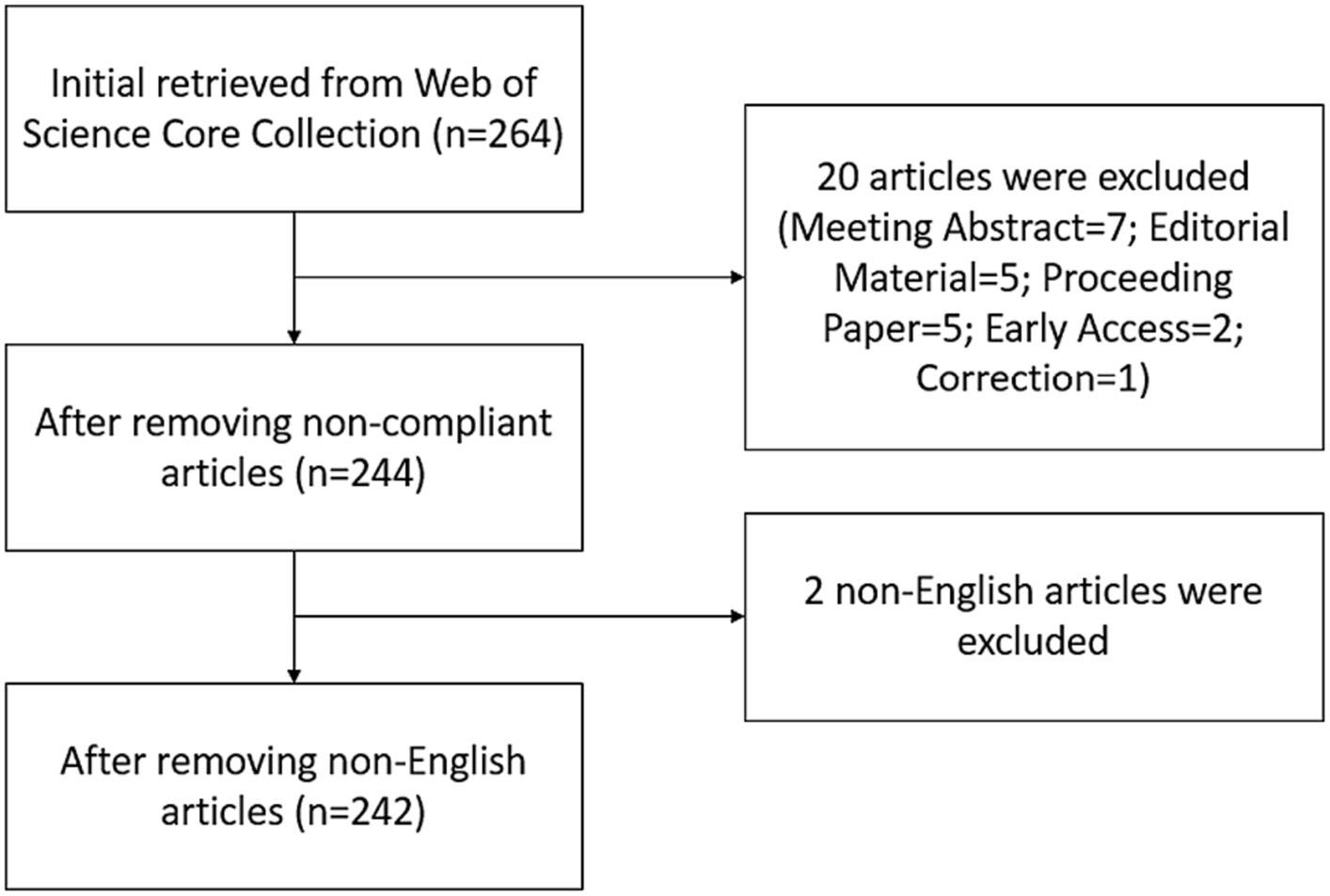
Figure 1. Flow chart of the literature search in the field of body–mind exercise for patients with mild cognitive impairment.
2.2 Analysis tool
To perform this bibliometric analysis, three software programs, CiteSpace, VOSviewer, and Microsoft Excel, were used to analyze the data downloaded from WoSCC (40, 41). CiteSpace is a Java-based software that has been used extensively in bibliometric analysis and knowledge map visualizations. In this research, the reference co-citation network, and the co-occurring author keyword network in CiteSpace were applied to generate maps of knowledge structures of BME for MCI. As a key function of co-citation networks and co-occurring keyword networks that can characterize the intensity and frequency of mentions of an item over time (42), citation bursts were employed to describe research trends in this study. Due to its advantages in generating visual graphs and handling big data in bibliometric analysis, VOSviewer was used in this study to generate the collaborative networks of countries, institutions, and authors who published in the field of BME for MCI. VOSviewer automatically calculated the total link strength (TLS), which represents the number of co-occurrences of two items (countries/institutions/authors) in publications. Meanwhile, the average citations per item (ACI) was derived by dividing the total number of citations for the item automatically generated by VOSviewer by the number of publications of the item. Microsoft Excel was used to generate publication and citation trends in the field of BME for MCI.
3 Results
3.1 Annual publication activity
From 2013 to 2022, a total of 242 eligible publications were retrieved in the field of BME for MCI, which received a total of 4,118 citations, with 17.02 citations per publication. Among the 242 publications in the field of BME for MCI, 143 publications were “Article,” and 99 publications were “Review Article.” Figure 2 clearly illustrates the rapid upward trend in the past 10 years in both publications and citations in the field of BME for MCI. Annual publications in this field topped 10 for the first time in 2016 and then peaked in 2021 and 2022 (53 publications). Meanwhile, annual citations also grew rapidly after first exceeding 100 times in 2016 and then surpassing 1,000 times in 2021 until peaking in 2022 (1,382 times). In addition, 182 of the 242 publications in this field over the past decade received at least one grant (75.21%) and were published in 50 Web of Science categories. Geriatrics & Gerontology (72 publications, 29.75%), Neurosciences (49 publications, 20.25%), Psychiatry (33 publications, 13.64%), Gerontology (31 publications, 12.81%), and Clinical Neurology (22 publications, 9.09%) were the top five categories that had the largest number of publications in the field of BME for MCI.
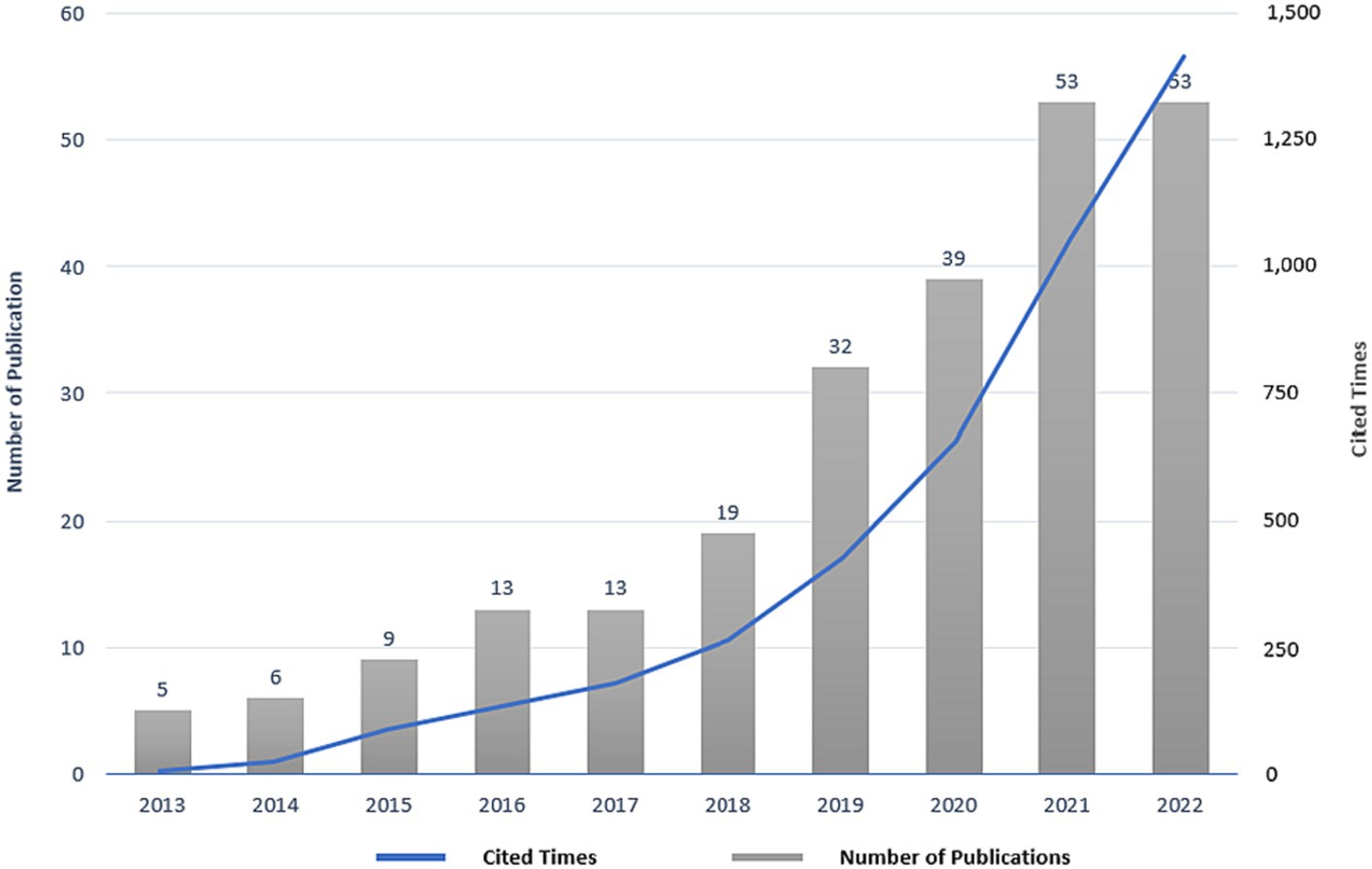
Figure 2. Annual distribution of publications and citations in the field of body–mind exercise for patients with mild cognitive impairment.
3.2 Analysis of national and institutional productivity
According to the results from WoSCC, a total of 42 countries/regions, as well as 635 institutions contributed to at least one publication in the field of BME for MCI in the past decade. Table 1 shows the countries and institutions that contributed to the largest number of publications in the field of BME for MCI from 2013 to 2022. China, with 78 publications (32.23%), and the USA, with 75 publications (30.99%), were the top two countries that published the largest number of documents in the field of BME for MCI and were well ahead of other countries. Furthermore, of the 11 countries with the highest scientific productivity in the field of BME for MCI, only China, Brazil, and Thailand are developing countries. Germany (ACI = 48.10), Thailand (ACI = 36.88), and Australia (ACI = 31.88) had the highest ACI, demonstrating the higher quality of their research in the field of BME for MCI. The USA and China held the strongest collaborative networks, and England, Canada, and Australia also had strong collaborations with other countries. Among the 12 institutions with the highest scientific productivity in the field of BME for MCI, eight are from the USA, three from China, and one from England. The Fujian University of Traditional Chinese Medicine in China contributed to the largest number of publications (12 publications, 4.96%) in the field of BME for MCI, followed by the Harvard Medical School in the USA (10 publications, 4.13%). Massachusetts General Hospital (ACI = 57.71) and the University of California, Los Angeles (ACI = 38.17) in the USA had the highest ACI, proposing that the two institutions had an early start and a high quality of research in the field of BME for MCI. Furthermore, the Fujian University of Traditional Chinese Medicine, the University of Florida, and the University of Washington had the strongest collaborative networks (TLS = 23) in the field of BME for MCI, whereas some institutions had very low collaborative intensity. The inter-country collaborative network in the field of BME for MCI is presented in Figure 3A, while Figure 3B shows the inter-institutional collaborative network in this field.

Table 1. Top 11 active countries and top 12 active institutions in the field of body–mind exercise for patients with mild cognitive impairment.
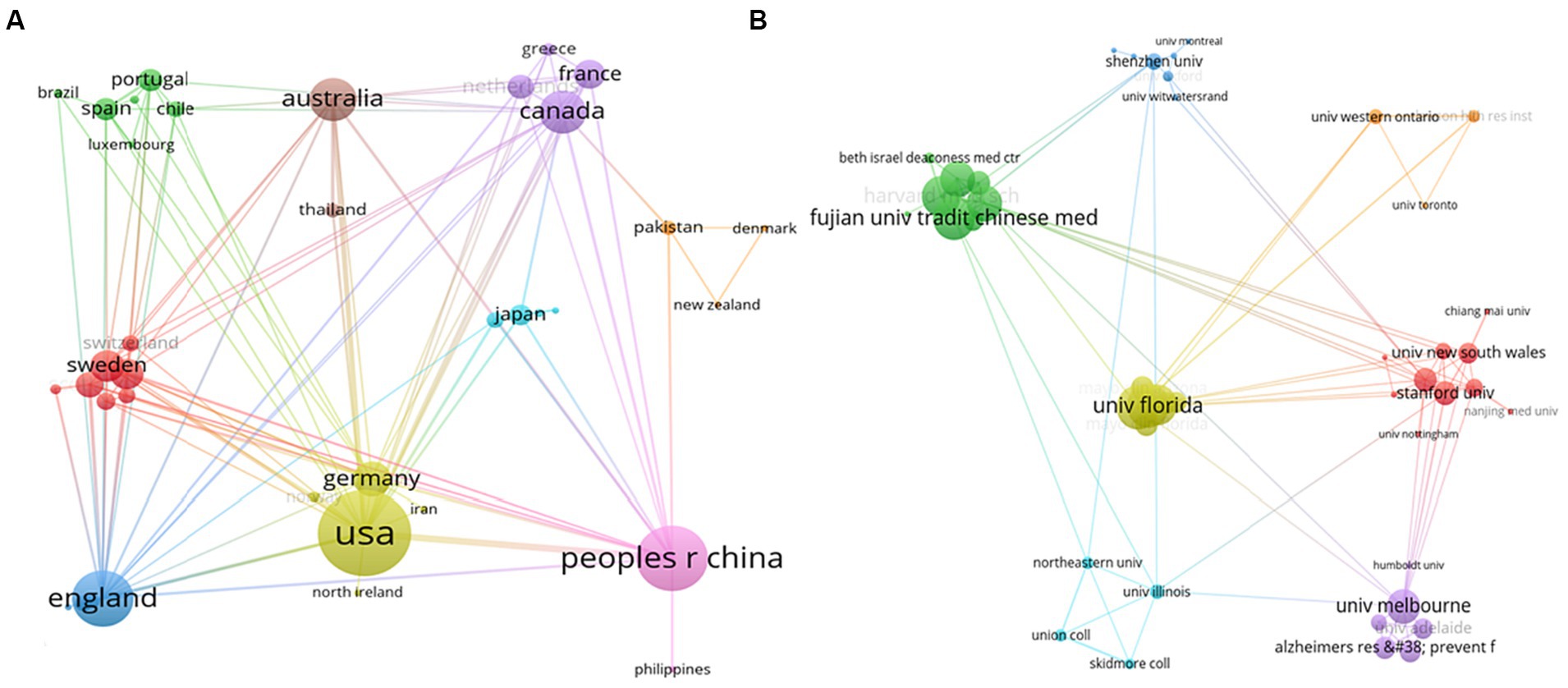
Figure 3. (A) Inter-country collaborative network in the field of body–mind exercise for patients with mild cognitive impairment. (B) Inter-institutional collaborative network in the field of body–mind exercise for patients with mild cognitive impairment.
3.3 Analysis of authors’ productivity
A total of 1,357 authors contributed to the 242 publications in the field of BME for MCI in the past decade, and Table 2 shows the 13 active authors with the largest number of publications. Chen, L of Fujian University of Traditional Chinese Medicine was the most prolific author in this field (12 publications, 4.96%), and the only author with more than 10 publications. Khalsa, DS of the Alzheimer’s Research & Prevention Foundation (ACI = 40.20), and Lavresky, H of the University of California, Los Angeles (ACI = 38.17), had the highest ACI in the field of BME for MCI, proposing that their research had high quality. Chen, L (TLS = 68), Li, M (TLS = 55), and Tao, J (TLS = 55) had the strongest collaborative networks. The inter-authorial collaborative network in the field of BME for MCI is illustrated in Figure 4.
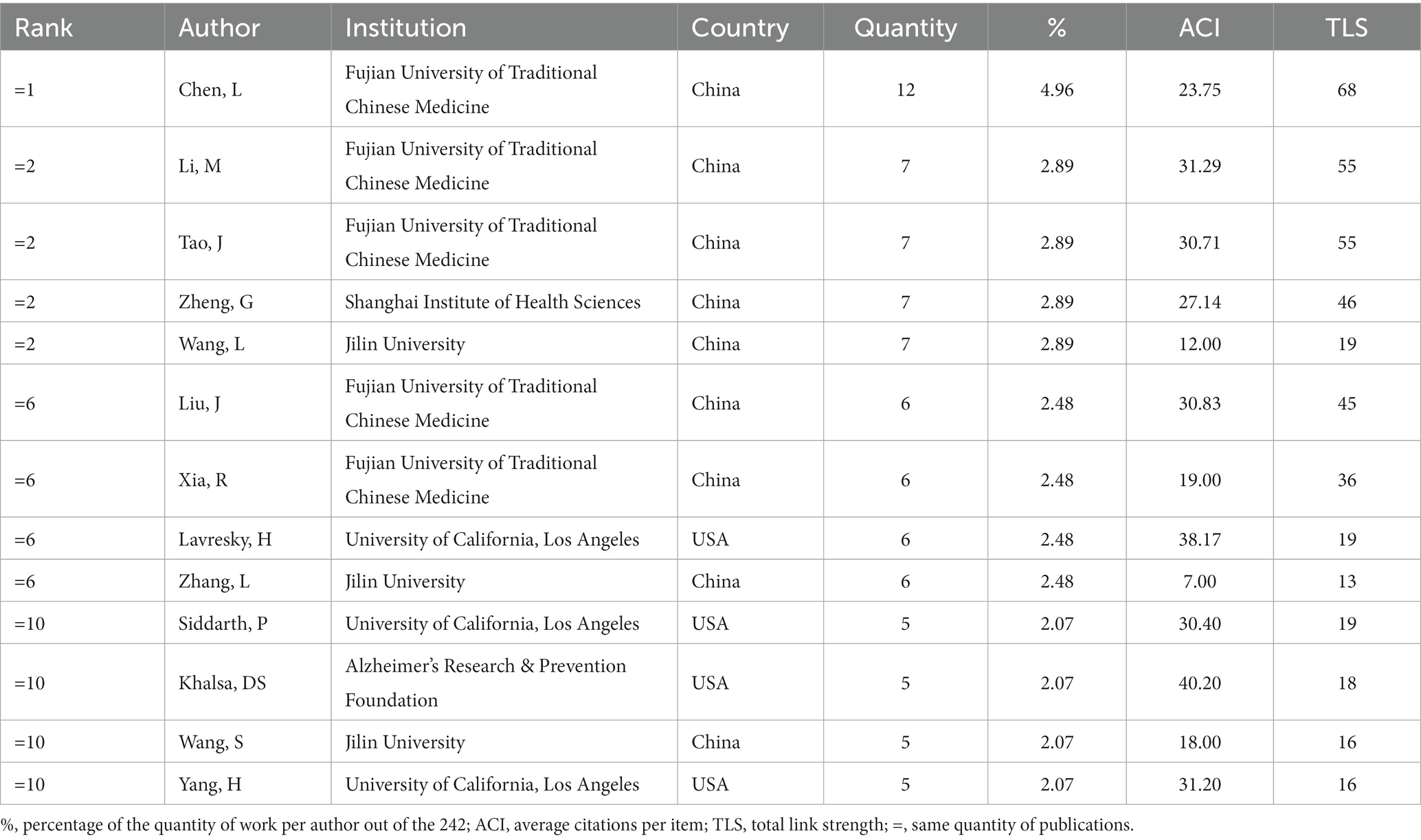
Table 2. Top 13 active authors in the field of body–mind exercise for patients with mild cognitive impairment.
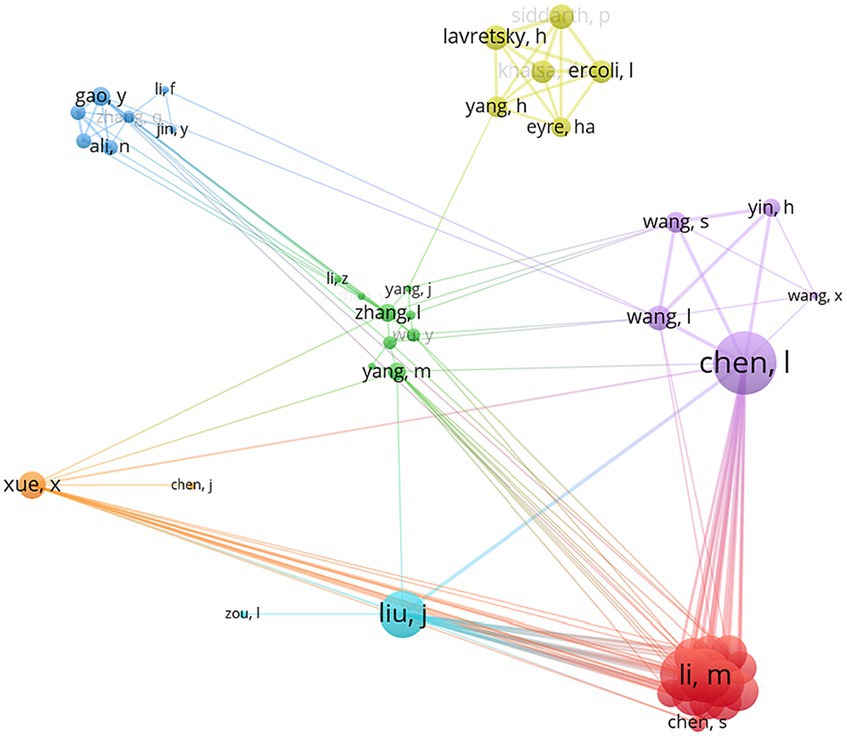
Figure 4. Inter-authorial collaborative network in the field of body–mind exercise for patients with mild cognitive impairment.
3.4 Journal characteristics
A total of 242 publications in the past decade in the field of BME for MCI were published by 127 journals, while the top 14 journals which published the largest number of documents are presented in Table 3. Frontiers in Aging Neuroscience (16 publications, 6.61%), and JOURNAL OF ALZHEIMER’S DISEASE (12 publications, 4.96%) were the two journals publishing the largest number of documents in the field of BME for MCI. Meanwhile, Frontiers in Aging Neuroscience [Impact factor (IF) = 5.702], and Frontiers in Psychiatry (IF = 5.435) were the only two journals with an IF of more than 5, suggesting that publishing research in the field of BME for MCI in high quality journals is still challenging.
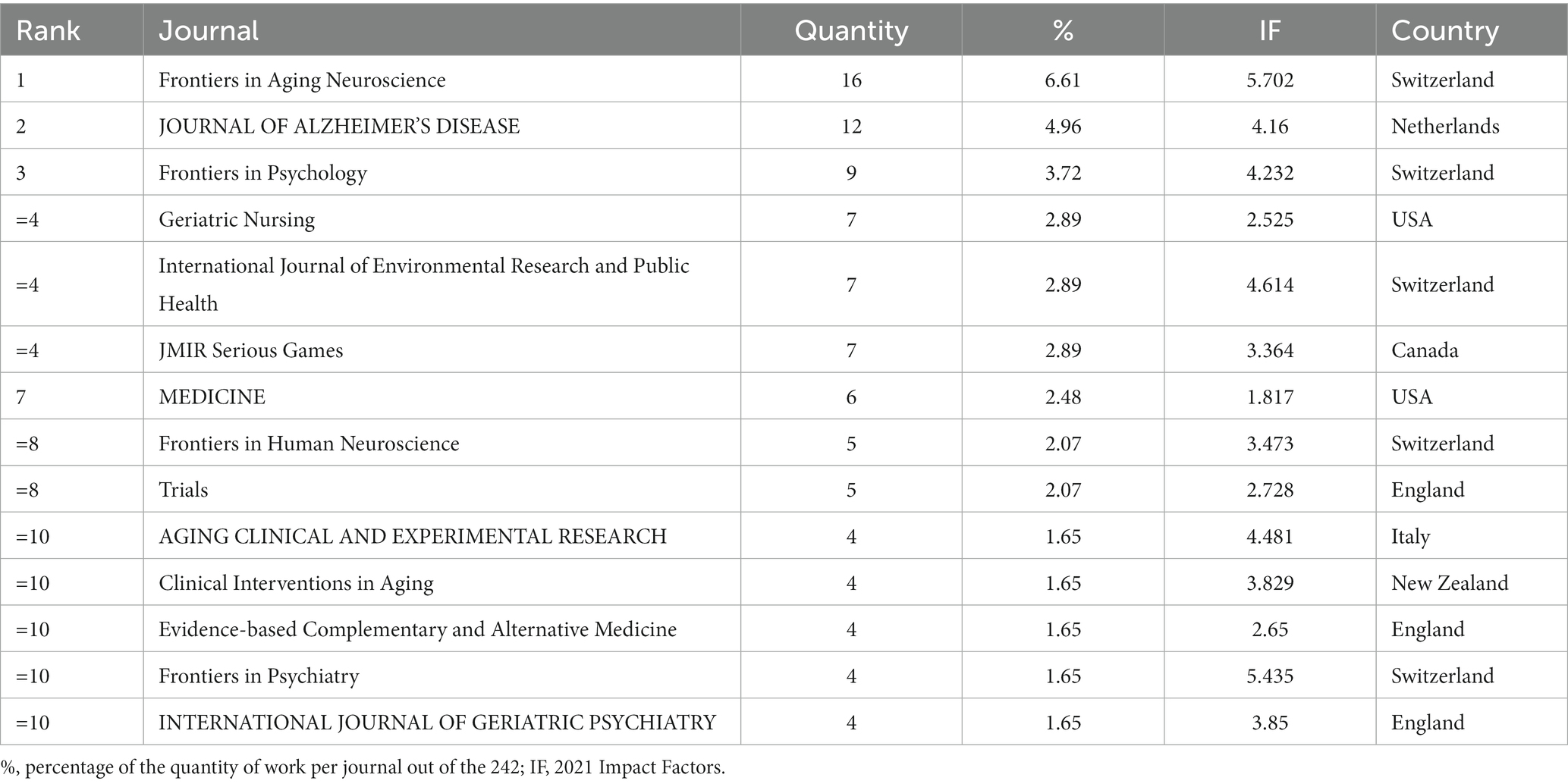
Table 3. Top 14 active journals in the field of body–mind exercise for patients with mild cognitive impairment.
3.5 Keyword analysis
The occurrence of the author’s keywords reflects the degree of interest in the field of BME for MCI and can predict future research trends. Meanwhile, the centrality of items was calculated automatically through CiteSpace, while nodes with high centrality represented their critical or turning point significance in a particular research field (43). The 14 most frequently occurring authors’ keywords in the field of BME for MCI are shown in Table 4. MCI was the most frequently occurring keyword and had the highest centrality (0.88). Tai Chi, Older Adults, and Alzheimer’s Disease were also commonly occurring. It is clearly shown in Figure 5 that the top 10 keywords with the strongest citation bursts in the field of BME for MCI in the past decade. The blue line represents the timeline from 2013 to 2022, while the red line represents the duration of the keyword outbreak from 2013 to 2022. In the last decade, body–mind exercise (Burst = 1.66) and Alzheimer’s Disease (Burst = 1.36) were the keywords with the highest citation burst value, as well as the keywords with the longest duration of burst. Since 2020, quality of life has been the keyword with the highest burst value in the field of BME for MCI.
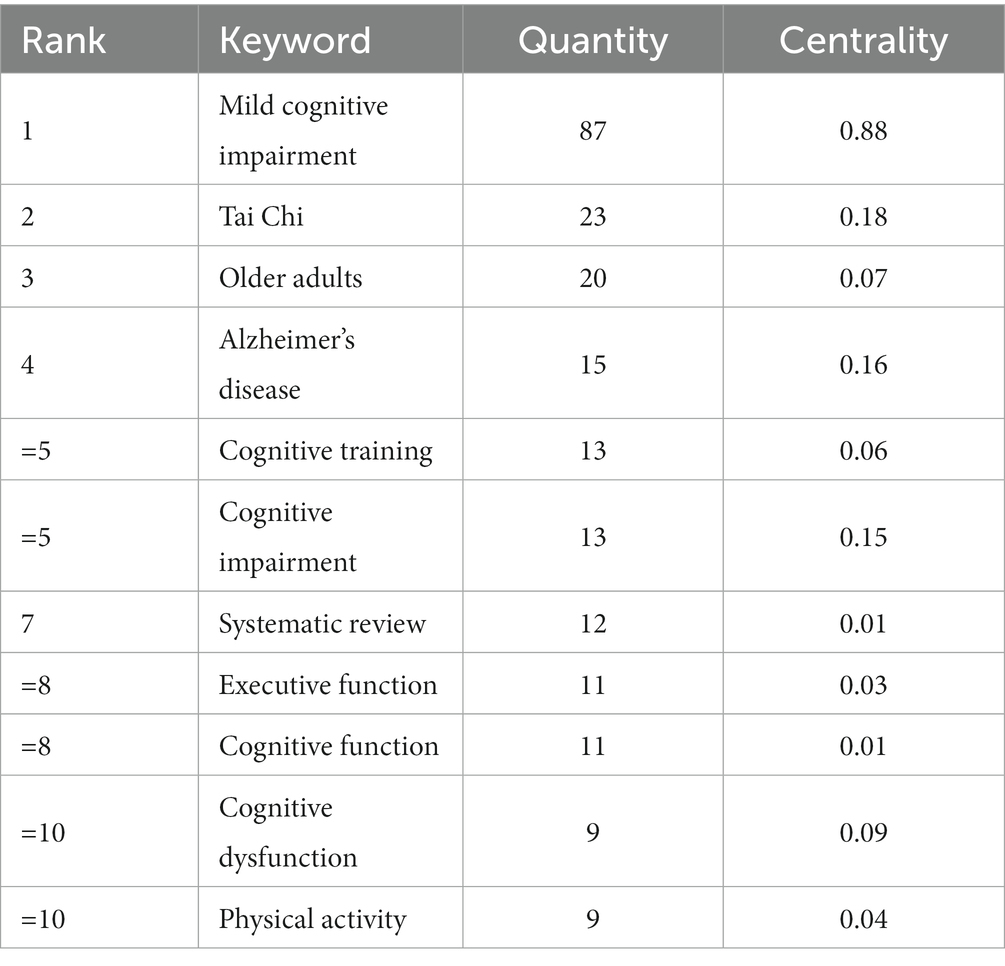
Table 4. Top 11 high-frequency keyword in the field of body–mind exercise for patients with mild cognitive impairment.
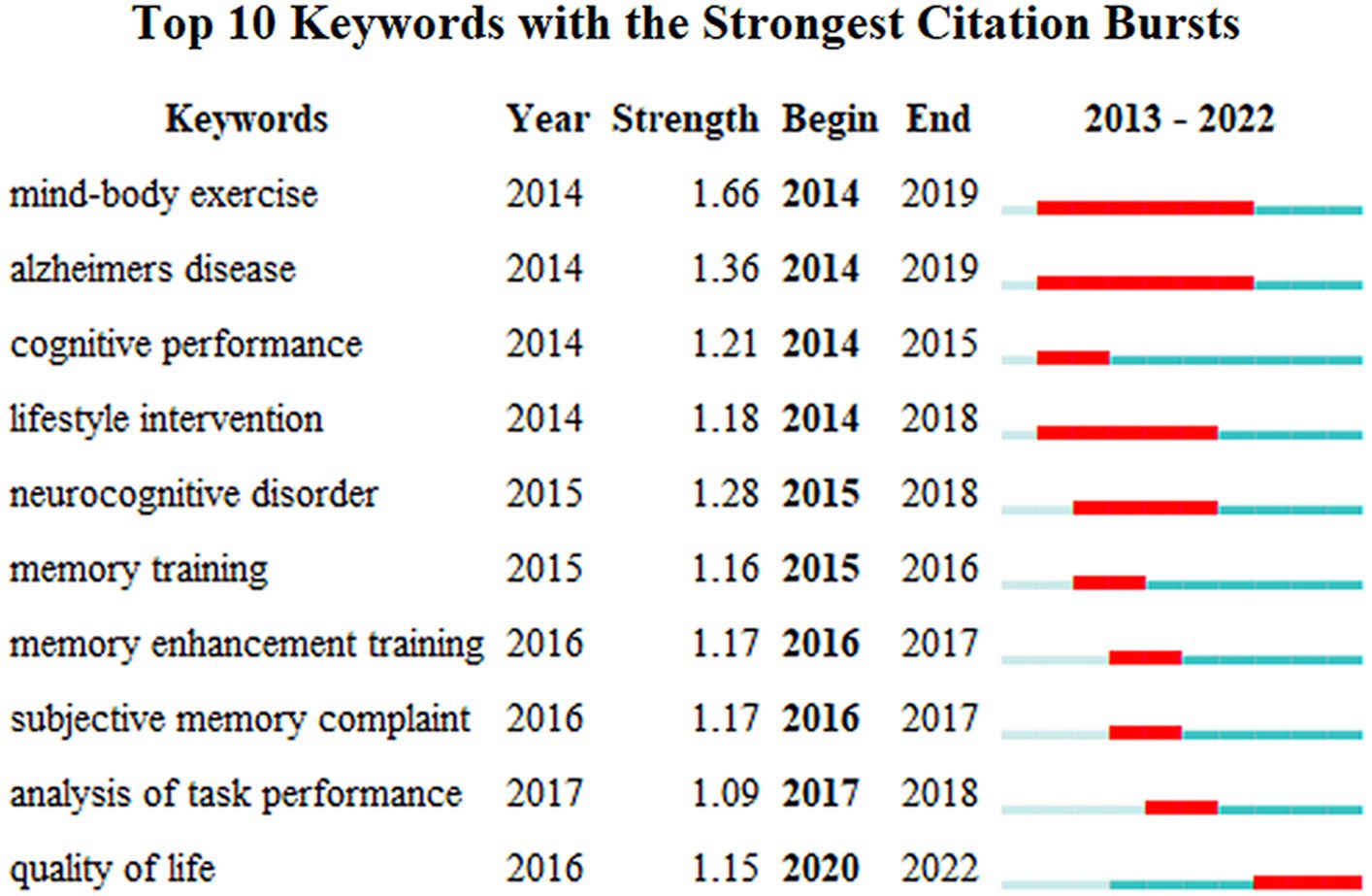
Figure 5. Top 10 keywords with the strongest citation bursts in the field of body–mind exercise for patients with mild cognitive impairment.
3.6 Reference analysis
The five most cited publications in the field of BME for MCI are shown in Table 5. These five most-cited publications received a total of 719 citations, and only one of the five publications was “Article.” The most cited publication in this field is entitled “Effect of Tai Chi on Cognitive Performance in Older Adults: Systematic Review and Meta-Analysis” (220 times). Wayne et al. (44) systematically reviewed the effectiveness of Tai Chi on overall cognitive function among older adults with normal or pathological cognitive declines (including MCI), and reported that Tai Chi, as a BME, is promising in improving cognitive function in this population. The five most cited articles were all published in journals whose IF was greater than 5, such as COCHRANE DATABASE OF SYSTEMATIC REVIEWS (IF = 11.874), and NEUROSCIENCE AND BIOBEHAVIORAL REVIEWS (IF = 9.062).
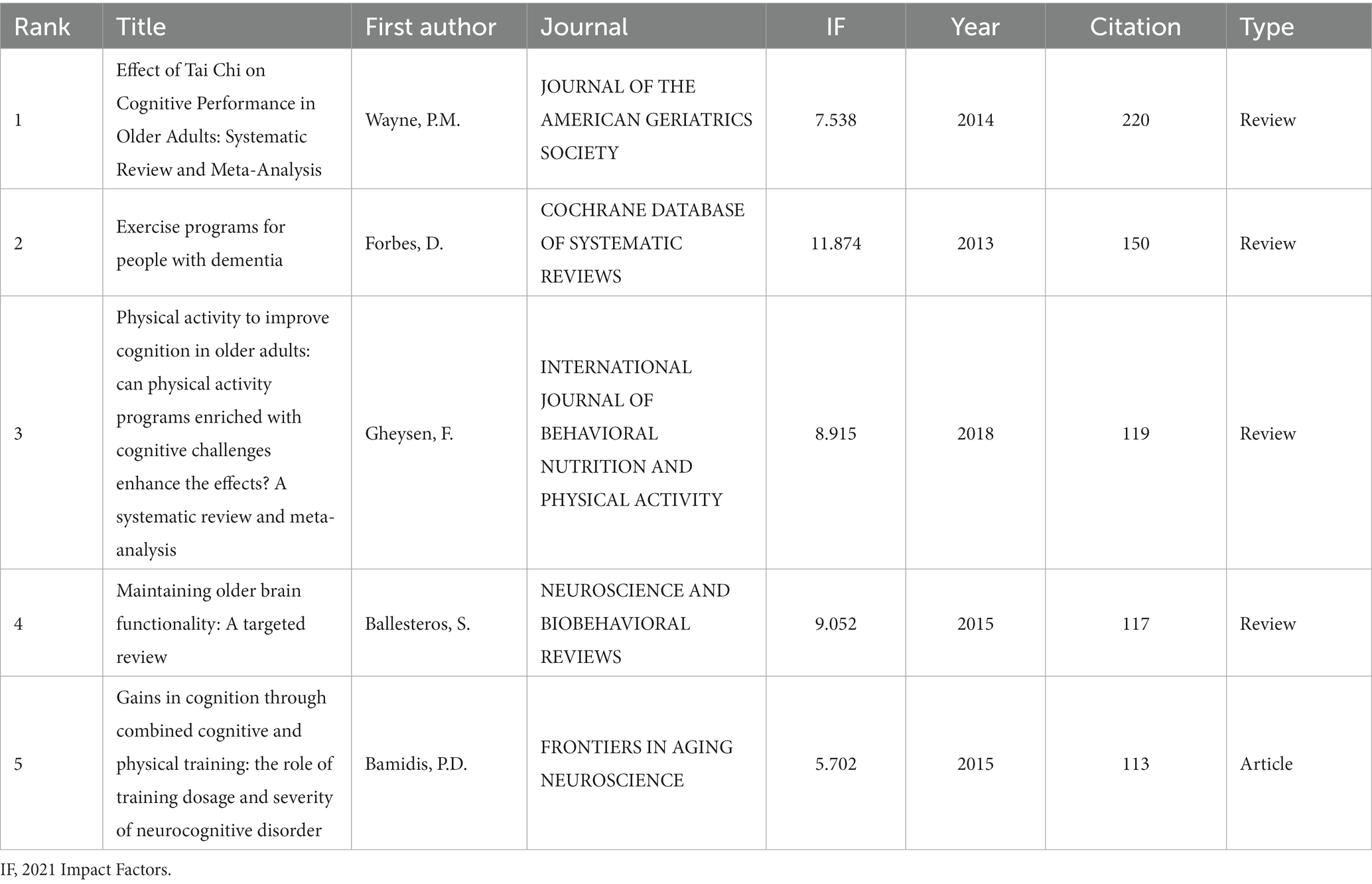
Table 5. Top 5 most-cited publications in the field of body–mind exercise for patients with mild cognitive impairment.
This study conducted an analysis of the reference co-citation network by CiteSpace to explore hotspots and trends in the field of BME for MCI. To measure the validity of clustering strategy, the modularity value (Q) and the weighted average silhouette value (S) were automatically calculated with CiteSpace, while Q > 0.5 and S > 0.7 are the recognized validity thresholds. Therefore, the clustering strategy in this study was valid and reasonable due to its Q = 0.7879 and S = 0.9276. Figure 6 clearly shows the cluster view of the knowledge map of the field of BME for MCI over the past decade, in which 13 clusters were found. Cluster #0 dual-task training had the largest size, followed by #1 Alzheimer’s disease, #2 baduanjin, and #3 yoga. Dual-task training is another description of BME, as we also included this terminology in our search strategy (45). Alzheimer’s disease is the most common type of dementia, and MCI has the potential to progress to Alzheimer’s disease (46). Baduanjin and yoga are two common BME that have been increasingly investigated as potential ways to manage MCI. Meanwhile, a timeline view of clusters, which describes their evolutionary process, is shown in Figure 7. The top 10 co-cited references with the strongest citation bursts are shown in Figure 8, with Erickson et al. (47) having the strongest burst (Burst = 7.49), followed by Song et al. (48) (Burst = 5.28). From 2019 onwards, the publications by Song et al. (48), Livingston et al. (49), and Petersen et al. (50) have been at the frontiers of the burst.
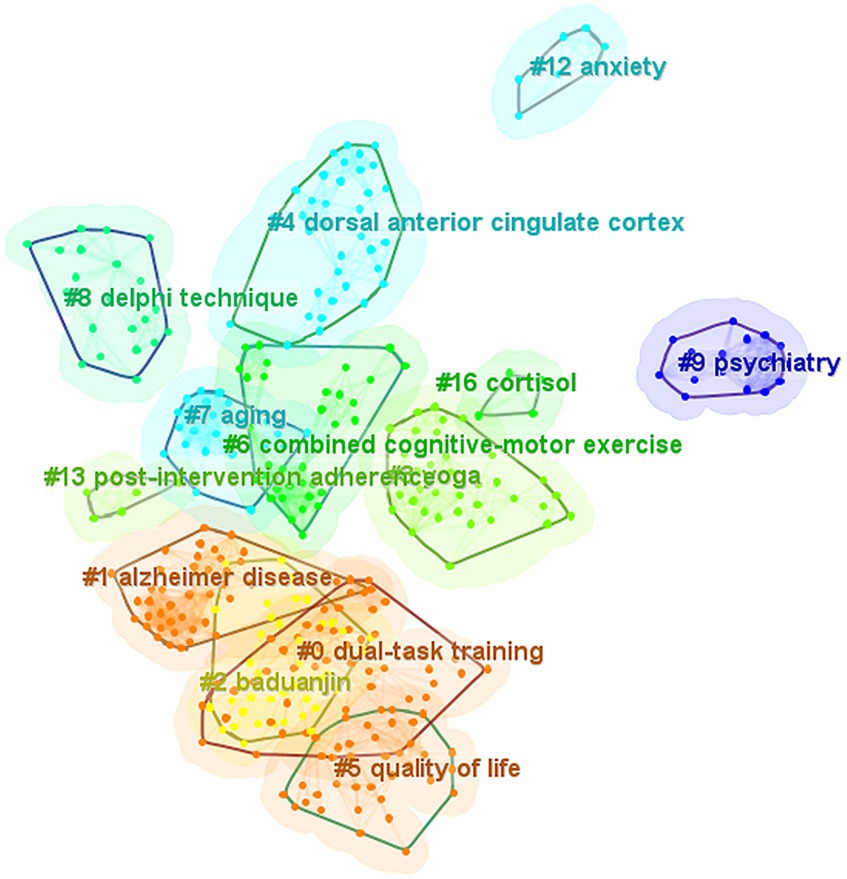
Figure 6. The cluster view of the knowledge map based on reference co-citation analysis in the field of body–mind exercise for patients with mild cognitive impairment.
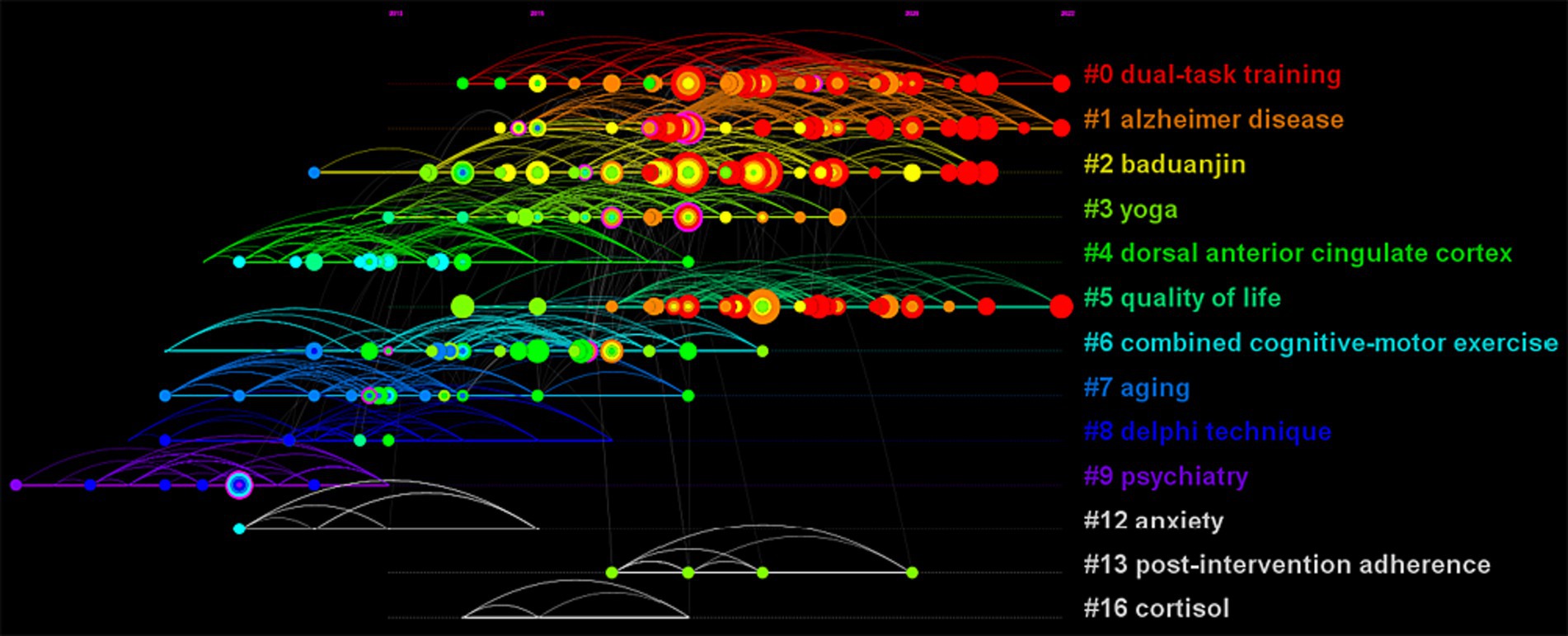
Figure 7. The timeline view of the knowledge map based on reference co-citation analysis in the field of body–mind exercise for patients with mild cognitive impairment.
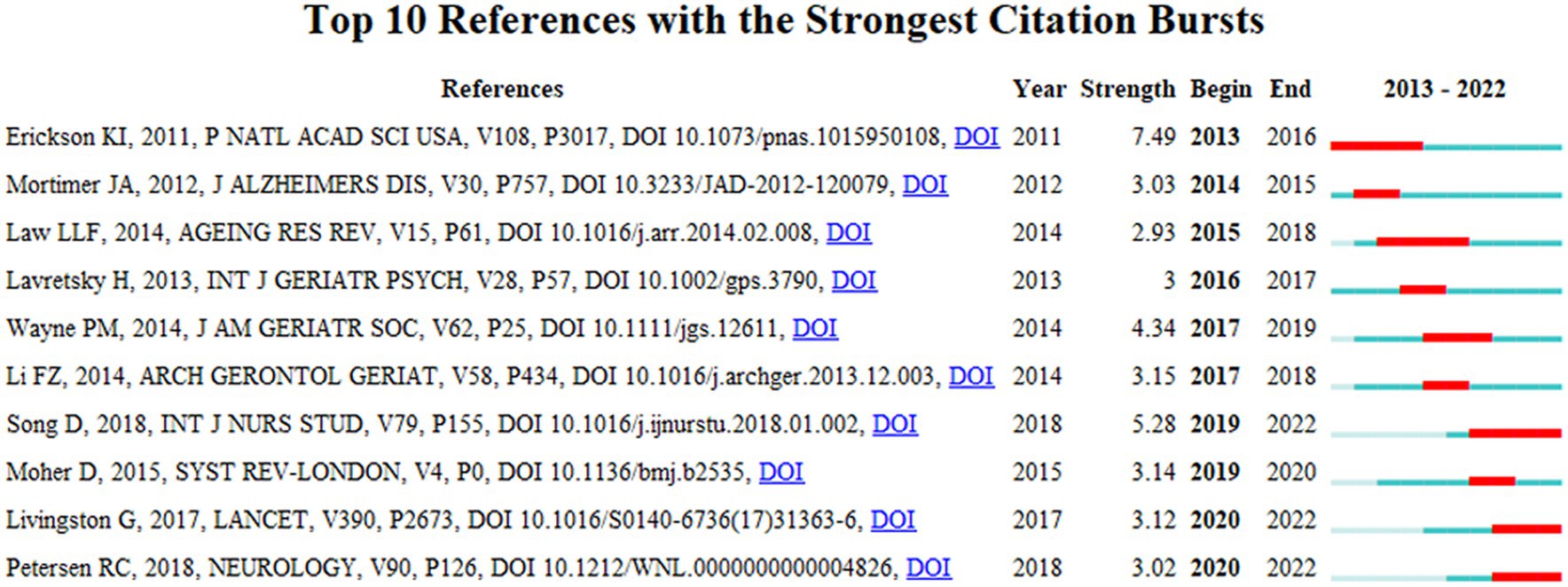
Figure 8. Top 10 references with the strongest citation bursts in the field of body–mind exercise for patients with mild cognitive impairment.
4 Discussion
This is the first study to systematically analyze the productivity, research hotspots, and future research trends within the field of BME for MCI over the past decade using a robust bibliometrics approach. The rapid increase in the past decade in both publications and citations in the field of BME for MCI is indicative of the continued steady increase in interest and input from researchers and other stakeholders within the field. Review articles accounted for 40.91% of total publications, which is higher than the results from bibliometric analyses in related fields (33). One possible explanation is that in recent years, having been affected by the COVID-19 pandemic, patients with MCI have been defined by some ethical committees as a vulnerable population and cannot be accessed by intervention studies or epidemiological investigations (51). The proportion of funded research in this area was similar to previous figures for related fields (52), indicating that the field of BME for MCI is preferred by funding agencies and has a large scientific and translational potential. Publications in this field were mainly classified as Geriatrics & Gerontology and Neurosciences, indicating that research in this field was multidisciplinary involving the intersection of geriatrics, neuroscience, and exercise science.
China and the USA were far ahead in terms of national productivity of publications, and Brazil and Thailand also had a high number or quality of publications. Tai Chi, Baduanjin and other BME are popular Chinese traditional exercises, while China also has the largest population of older adults and patients with MCI around the world (53). Therefore, the interest and investment in the field of BME for MCI in China is comprehensible and significant. Nevertheless, developed countries such as Germany and Australia had higher quality research than China. This suggests that developing countries such as China and Brazil need to continue to support research in the field of BME for MCI, and to enhance the quality of research through international exchange and cooperation.
In terms of institutional productivity, although Fujian University of Traditional Chinese Medicine in China was the most productive institution, American institutions occupied eight of the 11 most productive institutions in the field of BME for MCI. Moreover, the level of cooperation between all institutions was low, with some institutions in China having almost no interinstitutional cooperation. Therefore, more international and inter-institutional collaborations are urgently needed for subsequent research in this field. Chen, L was the most productive author in this field and had the strongest collaborative network. Nine of the top 13 most productive authors were from China, but the authors from the USA published higher-quality research. This suggests that Chinese researchers in this field need to improve the quality of their research while maintaining productivity and collaborating across institutions and countries. Furthermore, Frontiers in Aging Neuroscience and JOURNAL OF ALZHEIMER’S are the most popular journals. However, there appear to be some challenges in publishing research in this field in high-quality journals compared to other related fields (33).
Through co-occurrence keyword networks and reference co-citation networks, we identified BME, including Tai Chi and Baduanjin, as hotspots in the field of BME for MCI over the past decade. Tai Chi, a popular traditional Chinese exercise, is a moderate-intensity aerobic exercise that combines both physical and cognitive exercise (54). Research applying Tai Chi, as an intervention for patients with MCI has started relatively early, while Tai Chi has been demonstrated to be effective in enhancing general cognitive performance, memory, attention, and executive function in patients with MCI (55, 56). This may be since it obtains the benefits of both mind and body exercise. First, as moderate-intensity aerobic exercise, tai chi slows age-related brain atrophy, increases cerebral blood circulation, and even alters brain plasticity (57, 58). Second, as a cognitively stimulating activity, Tai Chi requires learning, memorizing, and performing a series of sequential choreographed movements, which promote cognitive functions in participants performing Tai Chi (59). Baduanjin is another traditional Chinese exercise that has been popular in China for more than a thousand years as an important part of the Qigong method (60). Compared to Tai Chi, Baduanjin is a more accessible type of BME and was used later to intervene with patients with MCI but has certainly become a popular intervention in recent years. Previous meta-analyses proposed that Baduanjin also enhanced general cognitive function and executive function among patients with MCI (61, 62). As a BME, Baduanjin may have similar mechanisms of enhancing cognitive function in patients with MCI as Tai Chi. First, Baduanjin improves cardiopulmonary function by controlling breathing, thus enhancing the inhibitory control sublevel of executive function (63). Second, in the practice of Baduanjin, older adults need working memory and executive functions to learn, memorize, and perform motor movements, thus improving their cognitive function (64). Tai Chi and Baduanjin are hot research topics in the field of BME for MCI, they also have greatly promoted the role of traditional Chinese exercise in healthy aging. However, given the difficulty of acquiring these BMEs, there are challenges in promoting and researching them in countries outside of China. This may explain why there is little international or even inter-institutional cooperation in this field.
We identified the future research trends in the field of BME for MCI as evidence synthesis and guidelines through an analysis of bursts in co-occurrence keyword networks and reference co-citation networks. First, over 40% of the publications in this field were review articles. Apart from the limitations of interventions or investigations of patients with MCI during the COVID-19 pandemic, the large number of studies in this field published in Chinese may be another explanation.
However, systematic reviews allow researchers to synthesize evidence from studies published in both English and Chinese. For example, Lin et al. (61) included 13 randomized controlled trials published in Chinese in the meta-analysis. This is an advantage for Chinese researchers but also poses challenges. Mastering both English and Chinese can uniquely position them to synthesize evidence from original research in the field of BME for MCI, but it also limits their ability to internationalize and enhance the quality of evidence synthesis through international collaboration. Furthermore, the large number of publications in this field were published in Chinese and provided only English abstracts limit the development of open science in the field. Another frontier in this field is the guidelines. Livingston et al. (49) in the 2017 report of the Lancet Commission: Dementia prevention, intervention, and care stated that a combination of interventions is needed to delay the progression of MCI to dementia, such as treatment of vascular risk factors, diet, exercise, cognitive and social stimulation, etc. In the updated 2020 report, Livingston et al. (65) indicated that most meta-analyses on the effectiveness of cognitive training for patients with MCI were low-standard, positive, and mostly achieved statistical significance. Currently, there is also evidence that sleep plays an important role in the relationship between exercise and cognitive function (66–68). However, the clinical significance of the results remains uncertain due to the poor standards of the studies and the heterogeneity of the results. Furthermore, the American Academy of Neurology recommended that patients diagnosed with MCI should exercise twice a week, and may have cognitive interventions (50). However, this guideline also notes that the strength of evidence for exercise and cognitive interventions was insufficient and that heterogeneity in outcome measures needed to be reduced in subsequent studies, thus facilitating evidence synthesis and guideline development.
4.1 Limitation and further recommendations
Inevitably, there are limitations to this study. First, only one database, WoSCC, was utilized in this study, which may have led to the omission of high-quality studies that exist in other databases but were not indexed by WoSCC. Therefore, software developers are required to upgrade relevant bibliometric tools and algorithms in the future. Second, only English-published studies were included in this study, which may have overlooked high-quality studies published in other languages such as Chinese and Spanish. With advances in bibliometrics techniques as well as international cooperation, it may be possible in the future to minimize linguistic bias. Finally, some high-quality studies may have been overlooked due to late publication, thus not generating hotspots.
5 Conclusion
This study performed a bibliometric analysis of BME for MCI in the past decade using a robust methodology, describing knowledge structures, and hotspots, and predicting future research trends in this field. The results of this study help researchers to quickly grasp the knowledge structure in the field of BME for MCI, inform future research, and facilitate inter-institutional and international collaboration. Evidence synthesis and guidelines might be future research trends in this field. Future bibliometric research needs to reduce the limitations imposed by bibliometric techniques, language, and citation delays.
Data availability statement
The original contributions presented in the study are included in the article/Supplementary material, further inquiries can be directed to the corresponding author.
Author contributions
JZ: Writing – original draft, Writing – review & editing. ZY: Writing – original draft, Writing – review & editing. HF: Writing – original draft, Writing – review & editing.
Funding
The author(s) declare financial support was received for the research, authorship, and/or publication of this article. This work was supported in part by the Shanghai Educational Sciences Project (Grant No. C2023274P).
Conflict of interest
The authors declare that the research was conducted in the absence of any commercial or financial relationships that could be construed as a potential conflict of interest.
Publisher’s note
All claims expressed in this article are solely those of the authors and do not necessarily represent those of their affiliated organizations, or those of the publisher, the editors and the reviewers. Any product that may be evaluated in this article, or claim that may be made by its manufacturer, is not guaranteed or endorsed by the publisher.
Supplementary material
The Supplementary material for this article can be found online at: https://www.frontiersin.org/articles/10.3389/fneur.2024.1351741/full#supplementary-material
References
1. Jia, L , Du, Y , Chu, L , Zhang, Z , Li, F , Lyu, D, et al. Prevalence, risk factors, and management of dementia and mild cognitive impairment in adults aged 60 years or older in China: a cross-sectional study. Lancet Public Health. (2020) 5:e661–71. doi: 10.1016/S2468-2667(20)30185-7
2. Gauthier, S , Reisberg, B , Zaudig, M , Petersen, RC , Ritchie, K , Broich, K, et al. Mild cognitive impairment. Lancet. (2006) 367:1262–70. doi: 10.1016/S0140-6736(06)68542-5
3. Biessels, GJ , and Ryan, CM . 4.22 - cognitive dysfunction in diabetes mellitus In: DW Pfaff and M Joëls, editors. Hormones, brain and behavior. 3rd ed. Oxford: Academic Press (2017). 421–43.
4. Bai, W , Chen, P , Cai, H , Zhang, Q , Su, Z , Cheung, T, et al. Worldwide prevalence of mild cognitive impairment among community dwellers aged 50 years and older: a meta-analysis and systematic review of epidemiology studies. Age Ageing. (2022) 51:afac173. doi: 10.1093/ageing/afac173
5. Gillis, C , Mirzaei, F , Potashman, M , Ikram, MA , and Maserejian, N . The incidence of mild cognitive impairment: a systematic review and data synthesis. Alzheimers Dement. (2019) 11:248–56. doi: 10.1016/j.dadm.2019.01.004
6. Petersen, RC , Roberts, RO , Knopman, DS , Geda, YE , Cha, RH , Pankratz, VS, et al. Prevalence of mild cognitive impairment is higher in men. The Mayo Clinic study of aging. Neurology. (2010) 75:889–97. doi: 10.1212/WNL.0b013e3181f11d85
7. Langa, KM , and Levine, DA . The diagnosis and management of mild cognitive impairment: a clinical review. JAMA. (2014) 312:2551–61. doi: 10.1001/jama.2014.13806
8. Dubois, B , Feldman, HH , Jacova, C , Cummings, JL , Dekosky, ST , Barberger-Gateau, P, et al. Revising the definition of Alzheimer's disease: a new lexicon. Lancet Neurol. (2010) 9:1118–27. doi: 10.1016/S1474-4422(10)70223-4
9. Petersen, RC , Smith, GE , Waring, SC , Ivnik, RJ , Tangalos, EG , and Kokmen, E . Mild cognitive impairment: clinical characterization and outcome. Arch Neurol. (1999) 56:303–8. doi: 10.1001/archneur.56.3.303
10. Tierney, MC , Szalai, JP , Dunn, E , Geslani, D , and Mcdowell, I . Prediction of probable Alzheimer disease in patients with symptoms suggestive of memory impairment. Value of the Mini-mental state examination. Arch Fam Med. (2000) 9:527–32. doi: 10.1001/archfami.9.6.527
11. Canevelli, M , Grande, G , Lacorte, E , Quarchioni, E , Cesari, M , Mariani, C, et al. Spontaneous reversion of mild cognitive impairment to Normal cognition: a systematic review of literature and meta-analysis. J Am Med Dir Assoc. (2016) 17:943–8. doi: 10.1016/j.jamda.2016.06.020
12. Koepsell, TD , and Monsell, SE . Reversion from mild cognitive impairment to normal or near-normal cognition: risk factors and prognosis. Neurology. (2012) 79:1591–8. doi: 10.1212/WNL.0b013e31826e26b7
13. Sun, M , Mainland, BJ , Ornstein, TJ , Mallya, S , Fiocco, AJ , Sin, GL, et al. The association between cognitive fluctuations and activities of daily living and quality of life among institutionalized patients with dementia. Int J Geriatr Psychiatry. (2018) 33:e280–5. doi: 10.1002/gps.4788
14. Zhu, CW , Sano, M , Ferris, SH , Whitehouse, PJ , Patterson, MB , and Aisen, PS . Health-related resource use and costs in elderly adults with and without mild cognitive impairment. J Am Geriatr Soc. (2013) 61:396–402. doi: 10.1111/jgs.12132
15. Lin, J.S. , O'connor, E. , Rossom, R.C. , Perdue, L.A. , Burda, B.U. , Thompson, M., et al. (2013). U.S. preventive services task force evidence syntheses, formerly systematic evidence reviews, in screening for cognitive impairment in older adults: an evidence update for the U.S. preventive services task force. Available at: https://www.ncbi.nlm.nih.gov/books/NBK174643/ (Accessed January 8, 2024)
16. Russ, TC , and Morling, JR . Cholinesterase inhibitors for mild cognitive impairment. Cochrane Database Syst Rev. (2012) 2016:CD009132. doi: 10.1002/14651858.CD009132.pub2
17. Snitz, BE , O'meara, ES , Carlson, MC , Arnold, AM , Ives, DG , Rapp, SR, et al. Ginkgo biloba for preventing cognitive decline in older adults: a randomized trial. JAMA. (2009) 302:2663–70. doi: 10.1001/jama.2009.1913
18. Huang, X , Zhao, X , Li, B , Cai, Y , Zhang, S , Wan, Q, et al. Comparative efficacy of various exercise interventions on cognitive function in patients with mild cognitive impairment or dementia: a systematic review and network meta-analysis. J Sport Health Sci. (2022) 11:212–23. doi: 10.1016/j.jshs.2021.05.003
19. Ye, M , Wang, L , Xiong, J , and Zheng, G . The effect of mind-body exercise on memory in older adults: a systematic review and meta-analysis. Aging Clin Exp Res. (2021) 33:1163–73. doi: 10.1007/s40520-020-01557-5
20. Lord, SR . Virtual reality and the prevention of falls in the real world. Lancet. (2016) 388:1132–4. doi: 10.1016/S0140-6736(16)31347-2
21. Mirelman, A , Rochester, L , Maidan, I , Del Din, S , Alcock, L , Nieuwhof, F, et al. Addition of a non-immersive virtual reality component to treadmill training to reduce fall risk in older adults (V-TIME): a randomised controlled trial. Lancet. (2016) 388:1170–82. doi: 10.1016/S0140-6736(16)31325-3
22. Schoene, D , Valenzuela, T , Lord, SR , and De Bruin, ED . The effect of interactive cognitive-motor training in reducing fall risk in older people: a systematic review. BMC Geriatr. (2014) 14:107. doi: 10.1186/1471-2318-14-107
23. Fabre, C , Chamari, K , Mucci, P , Masse-Biron, J , and Préfaut, C . Improvement of cognitive function by mental and/or individualized aerobic training in healthy elderly subjects. Int J Sports Med. (2002) 23:415–21. doi: 10.1055/s-2002-33735
24. Theill, N , Schumacher, V , Adelsberger, R , Martin, M , and Jäncke, L . Effects of simultaneously performed cognitive and physical training in older adults. BMC Neurosci. (2013) 14:103. doi: 10.1186/1471-2202-14-103
25. Hoy, S , Östh, J , Pascoe, M , Kandola, A , and Hallgren, M . Effects of yoga-based interventions on cognitive function in healthy older adults: a systematic review of randomized controlled trials. Complement Ther Med. (2021) 58:102690. doi: 10.1016/j.ctim.2021.102690
26. Liu, F , Chen, X , Nie, P , Lin, S , Guo, J , Chen, J, et al. Can tai chi improve cognitive function? A systematic review and meta-analysis of randomized controlled trials. J Altern Complement Med. (2021) 27:1070–83. doi: 10.1089/acm.2021.0084
27. Wang, Y , Zhang, Q , Li, F , Li, Q , and Jin, Y . Effects of tai chi and qigong on cognition in neurological disorders: a systematic review and meta-analysis. Geriatr Nurs. (2022) 46:166–77. doi: 10.1016/j.gerinurse.2022.05.014
28. Yang, J , Zhang, L , Tang, Q , Wang, F , Li, Y , Peng, H, et al. Tai chi is effective in delaying cognitive decline in older adults with mild cognitive impairment: evidence from a systematic review and meta-analysis. Evid Based Complement Alternat Med. (2020) 2020:3620534. doi: 10.1155/2020/3620534
29. Zou, L , Loprinzi, PD , Yeung, AS , Zeng, N , and Huang, T . The beneficial effects of mind-body exercises for people with mild cognitive impairment: a systematic review with meta-analysis. Arch Phys Med Rehabil. (2019) 100:1556–73. doi: 10.1016/j.apmr.2019.03.009
30. Donthu, N , Kumar, S , Mukherjee, D , Pandey, N , and Lim, WM . How to conduct a bibliometric analysis: an overview and guidelines. J Bus Res. (2021) 133:285–96. doi: 10.1016/j.jbusres.2021.04.070
31. Nakagawa, S , Samarasinghe, G , Haddaway, NR , Westgate, MJ , O’Dea, RE , Noble, DWA, et al. Research weaving: visualizing the future of research synthesis. Trends Ecol Evol. (2019) 34:224–38. doi: 10.1016/j.tree.2018.11.007
32. Sofik, S , Rahman, Z , and Nausheen, S . Productivity trends and pattern of scientific collaboration of bibliometric research: an exploratory analysis. Libr Philos Pract. (2021) 5930 Available at: https://digitalcommons.unl.edu/libphilprac/5930
33. Chen, B , Fu, Y , Song, G , Zhong, W , and Guo, J . Research trends and hotspots of exercise for Alzheimer’s disease: a bibliometric analysis. Front Aging Neurosci. (2022) 14:984705. doi: 10.3389/fnagi.2022.984705
34. Cai, M , Zhang, Y , Chen, S , Wu, Z , and Zhu, L . The past, present, and future of research on neuroinflammation-induced mild cognitive impairment: a bibliometric analysis. Front Aging Neurosci. (2022) 14:968444. doi: 10.3389/fnagi.2022.968444
35. Ullah, R , Asghar, I , and Griffiths, MG . An integrated methodology for bibliometric analysis: a case study of internet of things in healthcare applications. Sensors. (2022) 23:67. doi: 10.3390/s23010067
36. Martín-Martín, A , Orduna-Malea, E , Thelwall, M , and López-Cózar, ED . Google scholar, web of science, and Scopus: a systematic comparison of citations in 252 subject categories. J Informetr. (2018) 12:1160–77. doi: 10.1016/j.joi.2018.09.002
37. Yang, GY , Sabag, A , Hao, WL , Zhang, LN , Jia, MX , Dai, N, et al. Tai chi for health and well-being: a bibliometric analysis of published clinical studies between 2010 and 2020. Complement Ther Med. (2021) 60:102748. doi: 10.1016/j.ctim.2021.102748
38. Liu, M , Liu, B , Ye, Z , and Wu, D . Bibliometric analysis of electroencephalogram research in mild cognitive impairment from 2005 to 2022. Front Neurosci. (2023) 17:1128851. doi: 10.3389/fnins.2023.1128851
39. Cabanillas-Lazo, M , Quispe-Vicuña, C , Barja-Ore, J , Fernandez-Giusti, A , Munive-Degregori, A , Retamozo-Siancas, Y, et al. A 10-year bibliometric analysis of global research on gut microbiota and Parkinson's disease: characteristics, impact, and trends. Biomed Res Int. (2022) 2022:4144781. doi: 10.1155/2022/4144781
40. Chen, Y , You, Y , Wang, Y , Wang, Y , and Dai, T . Global insights into rural health Workers' job satisfaction: a scientometric perspective. Front Public Health. (2022) 10:895659. doi: 10.3389/fpubh.2022.895659
41. You, Y , Li, W , Liu, J , Li, X , Fu, Y , and Ma, X . Bibliometric review to explore emerging high-intensity interval training in health promotion: a new century picture. Front Public Health. (2021) 9:697633. doi: 10.3389/fpubh.2021.697633
42. Chen, C . CiteSpace II: detecting and visualizing emerging trends and transient patterns in scientific literature. J Am Soc Inf Sci. (2006) 57:359–77. doi: 10.1002/asi.20317
43. Pei, W , Peng, R , Gu, Y , Zhou, X , and Ruan, J . Research trends of acupuncture therapy on insomnia in two decades (from 1999 to 2018): a bibliometric analysis. BMC Complement Altern Med. (2019) 19:225. doi: 10.1186/s12906-019-2606-5
44. Wayne, PM , Walsh, JN , Taylor-Piliae, RE , Wells, RE , Papp, KV , Donovan, NJ, et al. Effect of tai chi on cognitive performance in older adults: systematic review and meta-analysis. J Am Geriatr Soc. (2014) 62:25–39. doi: 10.1111/jgs.12611
45. Fritz, NE , Cheek, FM , and Nichols-Larsen, DS . Motor-cognitive dual-task training in neurologic disorders: a systematic review. J Neurol Phys Ther. (2015) 39:142–53. doi: 10.1097/NPT.0000000000000090
46. Soria Lopez, JA , González, HM , and Léger, GC . Alzheimer's disease. Handb Clin Neurol. (2019) 167:231–55. doi: 10.1016/B978-0-12-804766-8.00013-3
47. Erickson, KI , Voss, MW , Prakash, RS , Basak, C , Szabo, A , Chaddock, L, et al. Exercise training increases size of hippocampus and improves memory. Proc Natl Acad Sci U S A. (2011) 108:3017–22. doi: 10.1073/pnas.1015950108
48. Song, D , Yu, DSF , Li, PWC , and Lei, Y . The effectiveness of physical exercise on cognitive and psychological outcomes in individuals with mild cognitive impairment: a systematic review and meta-analysis. Int J Nurs Stud. (2018) 79:155–64. doi: 10.1016/j.ijnurstu.2018.01.002
49. Livingston, G , Sommerlad, A , Orgeta, V , Costafreda, SG , Huntley, J , Ames, D, et al. Dementia prevention, intervention, and care. Lancet. (2017) 390:2673–734. doi: 10.1016/S0140-6736(17)31363-6
50. Petersen, RC , Lopez, O , Armstrong, MJ , Getchius, TSD , Ganguli, M , Gloss, D, et al. Practice guideline update summary: mild cognitive impairment: report of the guideline development, dissemination, and implementation Subcommittee of the American Academy of neurology. Neurology. (2018) 90:126–35. doi: 10.1212/WNL.0000000000004826
51. Bierer, BE , White, SA , Barnes, JM , and Gelinas, L . Ethical challenges in clinical research during the COVID-19 pandemic. J Bioeth Inq. (2020) 17:717–22. doi: 10.1007/s11673-020-10045-4
52. Yang, Z , Chen, S , Bao, R , Li, R , Bao, K , Feng, R, et al. Public health concern on sedentary behavior and cardiovascular disease: a bibliometric analysis of literature from 1990 to 2022. Medicina. (2022) 58:1764. doi: 10.3390/medicina58121764
53. Ren, R , Qi, J , Lin, S , Liu, X , Yin, P , Wang, Z, et al. The China Alzheimer report 2022. Gen Psychiatr. (2022) 35:e100751. doi: 10.1136/gpsych-2022-100751
54. Taylor-Piliae, RE . The effectiveness of tai chi exercise in improving aerobic capacity: an updated meta-analysis. Med Sport Sci. (2008) 52:40–53. doi: 10.1159/000134283
55. Miller, SM , and Taylor-Piliae, RE . Effects of tai chi on cognitive function in community-dwelling older adults: a review. Geriatr Nurs. (2014) 35:9–19. doi: 10.1016/j.gerinurse.2013.10.013
56. Zheng, ZW , Zhu, XY , Yin, SF , Wang, BX , Niu, YN , Huang, X, et al. Combined cognitive-psychological-physical intervention induces reorganization of intrinsic functional brain architecture in older adults. Neural Plast. (2015) 2015:713104:1–11. doi: 10.1155/2015/713104
57. Colcombe, SJ , Erickson, KI , Raz, N , Webb, AG , Cohen, NJ , Mcauley, E, et al. Aerobic fitness reduces brain tissue loss in aging humans. J Gerontol A Biol Sci Med Sci. (2003) 58:176–80. doi: 10.1093/gerona/58.2.m176
58. Cui, L , Tao, S , Yin, H-C , Shen, Q-Q , Wang, Y , Zhu, L-N, et al. Tai chi Chuan alters brain functional network plasticity and promotes cognitive flexibility. Front Psychol. (2021) 12:665419. doi: 10.3389/fpsyg.2021.665419
59. Kim, TH , Pascual-Leone, J , Johnson, J , and Tamim, H . The mental-attention tai chi effect with older adults. BMC Psychol. (2016) 4:29. doi: 10.1186/s40359-016-0137-0
60. Koh, TC . Baduanjin-an ancient Chinese exercise. Am J Chin Med. (1982) 10:14–21. doi: 10.1142/S0192415X8200004X
61. Lin, S , Guo, J , Nie, P , Chen, X , Guo, J , Lin, N, et al. Baduanjin for executive function in patients with mild cognitive impairment: a systematic review and meta-analysis. Complement Ther Clin Pract. (2022) 49:101626. doi: 10.1016/j.ctcp.2022.101626
62. Yu, L , Liu, F , Nie, P , Shen, C , Chen, J , and Yao, L . Systematic review and meta-analysis of randomized controlled trials assessing the impact of Baduanjin exercise on cognition and memory in patients with mild cognitive impairment. Clin Rehabil. (2021) 35:492–505. doi: 10.1177/0269215520969661
63. Panza, F , Lozupone, M , Solfrizzi, V , Sardone, R , Dibello, V , di Lena, L, et al. Different cognitive frailty models and health-and cognitive-related outcomes in older age: from epidemiology to prevention. J Alzheimers Dis. (2018) 62:993–1012. doi: 10.3233/JAD-170963
64. Xia, R , Wan, M , Lin, H , Ye, Y , Chen, S , and Zheng, GJNR . Effects of mind–body exercise Baduanjin on cognition in community-dwelling older people with mild cognitive impairment: a randomized controlled trial. Neuropsychol Rehabil. (2022) 33:1368–83. doi: 10.1080/09602011.2022.2099909
65. Livingston, G , Huntley, J , Sommerlad, A , Ames, D , Ballard, C , Banerjee, S, et al. Dementia prevention, intervention, and care: 2020 report of the lancet commission. Lancet. (2020) 396:413–46. doi: 10.1016/S0140-6736(20)30367-6
66. Bloomberg, M , Brocklebank, L , Hamer, M , and Steptoe, A . Joint associations of physical activity and sleep duration with cognitive ageing: longitudinal analysis of an English cohort study. Lancet Healthy Longev. (2023) 4:e345–53. doi: 10.1016/S2666-7568(23)00083-1
67. You, Y , Chen, Y , Fang, W , Li, X , Wang, R , Liu, J, et al. The association between sedentary behavior, exercise, and sleep disturbance: a mediation analysis of inflammatory biomarkers. Front Immunol. (2022) 13:1080782. doi: 10.3389/fimmu.2022.1080782
Keywords: body–mind exercise, mild cognitive impairment, knowledge structure, research trends, bibliometric analysis
Citation: Zhang J, Yang Z and Fan H (2024) Knowledge structure and future research trends of body–mind exercise for mild cognitive impairment: a bibliometric analysis. Front. Neurol. 15:1351741. doi: 10.3389/fneur.2024.1351741
Edited by:
Ioannis Liampas, University of Thessaly, GreeceReviewed by:
Ali Roziqin, Universitas Muhammadiyah Malang, IndonesiaYanwei You, Tsinghua University, China
Copyright © 2024 Zhang, Yang and Fan. This is an open-access article distributed under the terms of the Creative Commons Attribution License (CC BY). The use, distribution or reproduction in other forums is permitted, provided the original author(s) and the copyright owner(s) are credited and that the original publication in this journal is cited, in accordance with accepted academic practice. No use, distribution or reproduction is permitted which does not comply with these terms.
*Correspondence: Huiying Fan, ZmFuaHVpeWluZ0BzaG51LmVkdS5jbg==
†These authors share first authorship
 Jing Zhang
Jing Zhang Zhen Yang
Zhen Yang Huiying Fan
Huiying Fan